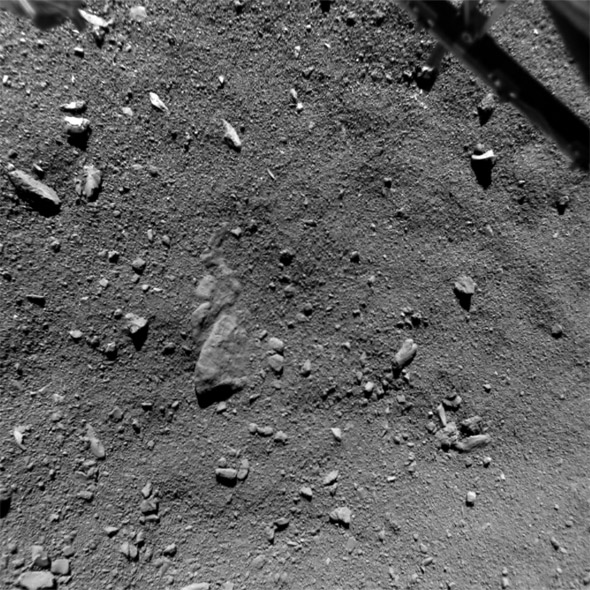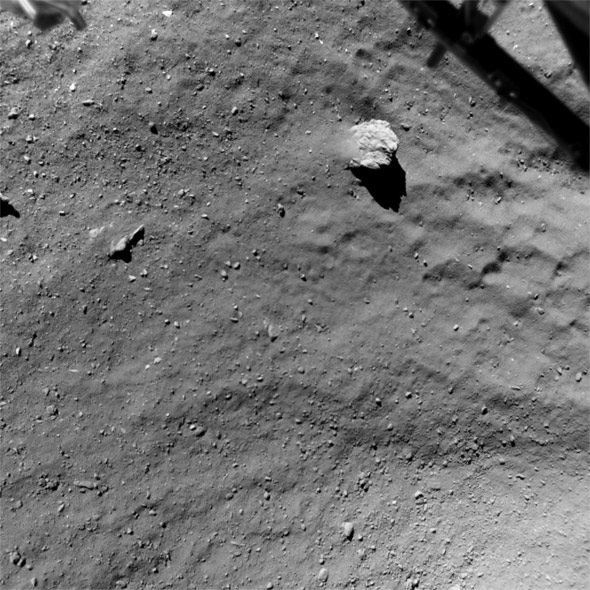Science
Related: About this forumA close up image of a comet

This shot was taken when the lander was a mere nine meters — 30 feet — from the surface of the comet. The area you’re seeing is 9.7 meters across, about the size of one half of a tennis court. It shows that the surface is covered in a course regolith (loose material that hasn’t consolidated into a solid mass; we see similar surfaces on airless bodies like the Moon), and rocks of various sizes, ranging from centimeters to meters across. You can also see material of different darkness; some are quite dark while others are reflective.
Some of the rocks are smooth, and some sharp. In one the papers published (Mottola et al.) they analyze the images, speculating that the smooth rocks may have once been embedded in ice or boulders, and then freed after the material they were embedded in disaggregated. The rougher ones with flat faces may be from bigger rocks that fell and shattered. Some of these chunks are partially buried in the regolith; are they being buried as the looser stuff piles up or being exhumed as the material moves away? Static pictures makes that difficult to discern.

From higher up there’s more of an overview; the shot above was taken when Philae was still 48.5 meters from first impact. The area seen is about 50 meters across, half the length of a football field. The big rock, nicknamed Cheops, is about 5 meters in size. It may be an individual piece, or an outcropping of bedrock below. What’s very interesting about it is the arrowhead-shaped depression is sits in (the point is to the right), and the fine-grained material piled up on its left. That’s a wind-blown feature! Material immediately upwind of a rock gets picked up and blown around the rock, leaving behind an arc-shaped moat, and a pile of finer grains on the rock’s downwind side.
more
http://www.slate.com/blogs/bad_astronomy/2015/08/03/philae_rosetta_comet_lander_s_first_science_results.html
alfredo
(60,071 posts)marble falls
(57,083 posts)phantom power
(25,966 posts)tclambert
(11,086 posts)Blue State Bandit
(2,122 posts)As the comet moves thru space on it's elliptical orbit, it passes thru gradients of ascending net charge (+ approaching perihelion) and descending net charge (- approaching aphelion). As the comet (net negative) approaches perihelion, the charge differential builds along the surface due to bombardment by a positive hydrogen proton stream from the sun. The dust (which consists mainly silica) will lift and move from net positive locations to net negative locations in an attempt to find equilibrium. The greater the charge differential, the greater the lifting of dust particles and the more glow discharge is seen. This is the comet reaching a charge equilibrium with its local environment.
This process flips as the comet approaches aphelion. Having a net positive charge from it's trip near the sun, the process reverses itself. This is why we see outbound comets discharge beyond Jupiter's orbit.
Most definitely NOT a dirty snowball.
marble falls
(57,083 posts)erronis
(15,257 posts)Thanks for posting these bits of science. This type of news is what will be real in 1,000 or 1,000,000 years. No one will remember any of the candidates for whatever country that was (if there are still countries.)
You mention the solar wind (particles from the sun) as affecting the surface. Would it also be possible that bombardments from other sources (gamma rays, etc.) over the course of a billion or so years would have any effect?
trusty elf
(7,393 posts)[img]
 [/img]
[/img]Wilms
(26,795 posts)Thor_MN
(11,843 posts)ornotna
(10,801 posts)That shadow doesn't look quite right.
![]()